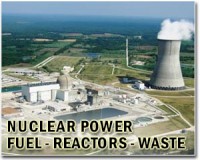 |
Chernobyl, Ukraine (AFP) Sept 23, 2010 Yellow Geiger counter in hand, the guide announces that radiation levels are 35 times higher than normal. Welcome to Chernobyl, the site in 1986 of the worst nuclear disaster in history and now an attraction visited by thousands of tourists every year. Nearly 25 years after a reactor at the Soviet-era plant exploded, the irradiated zone around Chernobyl is attracting curious visitors from around the world, from nuclear specialists to ordinary tourists, willing to pay 160 dollars (122 euros) a day to visit the zone. Described by US magazine Forbes as among the "world's unique places to visit," Chernobyl last year hosted about 7,500 visitors, according to official figures. On one recent trip, a small bus ferried tourists to the edge of the zone, forbidden to those without special permission. At the entrance, each signed a form promising to respect rules aimed at preventing contamination, including not eating or smoking outside, not touching anything and not sitting on the ground or even putting down personal belongings. The tourists signed the form with nervous laughs. A young Belgian psychologist, Davinia Schoutteten, admitted to being "a little bit scared" of the radiation and said she planned to throw away her shoes after the visit. She moved forward with the other tourists nonetheless, heading toward the infamous reactor, now covered in a cracked concrete shell. The Geiger counter registered radiation levels of 3.9 microsieverts, against a normal level of 0.12 microsieverts. After taking pictures of the reactor, the tourists headed to the abandoned city of Pripyat, built only three kilometres (two miles) from the nuclear plant to house its personnel and from where 50,000 residents were evacuated the day after the catastrophe. In the city, time was frozen. Soviet-era signs hung from buildings near a rusting fun park. Books and bits of toys sat in abandoned apartments. Hundreds of gas masks littered the floor of a school cafeteria. At the entrance to a classroom, a lesson plan for the next week -- including classes in reading, math, Russian and natural sciences -- was written in black and red ink on a piece of paper still pinned to the wall. "It's very sad. I can't help but feel very sad," said Bobby Harrington, a young woman visiting from Australia. "(It is) very beautiful and poetic but the whole tragedy makes me feel very uncomfortable with photographing it," she said, adding that she felt like she was intruding by seeing abandoned homes. "It's too early maybe. There are a lot of people still alive.... It's the voyeuristic element that I feel uncomfortable with," she said. But other tourists felt no hesitation about the site being made a tourist attraction, saying it was a testament to a historical event. "I always wanted to see this place, since it happened. It's a very important part of our recent history," said tourist Karl Backman, a Swedish musician. "I do not think it's bizarre. It's no different from the Coliseum, where people died... or from Auschwitz. It's history," he said. The disaster occurred on April 26, 1986 at 1:23 am, when one of Chernobyl's reactors exploded, contaminating the then-Soviet states of Ukraine, Russia and Belarus with the fallout also spreading to other parts of Europe. Thousands of people known as "liquidators" from Ukraine, Russia and Belarus have died since taking part in the bid to limit radioactive fallout after the catastrophe. The death toll from the Chernobyl disaster is bitterly disputed, with a United Nations toll from 2005 setting it at just 4,000, but non-governmental groups suggesting the true toll could reach tens or even hundreds of thousands. In Ukraine alone, 2.3 million people are designated officially as "having suffered from the catastrophe," including from higher cancer rates.
Share This Article With Planet Earth
Related Links Nuclear Power News - Nuclear Science, Nuclear Technology Powering The World in the 21st Century at Energy-Daily.com
 Russia expands Middle East nuke presence
Russia expands Middle East nuke presenceMoscow (UPI) Sep 22, 2010 Russia and Kuwait have signed a five-year nuclear cooperation agreement. The memorandum of understanding between the Kuwait National Nuclear Energy Committee and Russia's Rosatom State Atomic Energy Corporation was signed in Vienna on the sidelines of the 54th session of the General Conference of the International Atomic Energy Agency, Robsbalt news agency reported Wednesday. Ear ... read more |
|
| The content herein, unless otherwise known to be public domain, are Copyright 1995-2010 - SpaceDaily. AFP and UPI Wire Stories are copyright Agence France-Presse and United Press International. ESA Portal Reports are copyright European Space Agency. All NASA sourced material is public domain. Additional copyrights may apply in whole or part to other bona fide parties. Advertising does not imply endorsement,agreement or approval of any opinions, statements or information provided by SpaceDaily on any Web page published or hosted by SpaceDaily. Privacy Statement |